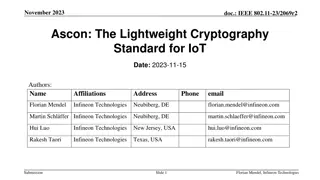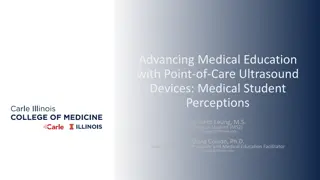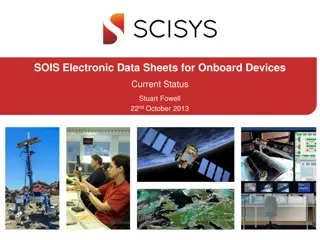ELECTRONIC VOTING PC HOME AFFAIRS March 2023
Delve into the realm of electronic voting systems with a comprehensive examination of defining e-voting, its types, global status, and valuable lessons learned from past experiences. Explore the controlled and uncontrolled environments of e-voting, including EVMs, DREs, and emerging technologies lik
0 views • 21 slides
Computer Peripherals and Interfacing
Computer peripherals are external devices that enhance the functionality of a computer. They include input devices like keyboards and mice, output devices like printers and monitors, and storage devices like hard disk drives and solid-state drives. Interfacing circuits connect these peripherals to t
1 views • 6 slides
IEEE Council on Electronic Design Automation (CEDA) - Empowering Innovation in Electronic Circuits and Systems
IEEE CEDA, established in 2005, focuses on the theory, implementation, and utilization of EDA/CAD tools for designing integrated electronic circuits and systems. The organization aims to lead in providing technical information and community services related to the design and automation of electronic
3 views • 19 slides
Ascon: The Lightweight Cryptography Standard for IoT
The November 2023 document IEEE 802.11-23/2069r2 discusses the importance of secure data storage and communication in IoT devices due to the increasing number of connected devices and potential security threats. It introduces Ascon as a lightweight cryptography standard selected by NIST for protecti
0 views • 26 slides
Lightweight Cryptography Standard for IoT - November 2023 IEEE Presentation
IEEE 802.11-23/2069r1 presents Ascon as a lightweight cryptography standard for IoT devices. With the increasing number of connected devices, protecting data on IoT devices becomes crucial. NIST selects Ascon to safeguard small devices, offering authenticated encryption and hashing efficiently. Asco
3 views • 26 slides
Understanding Network Devices and Connectivity
Network devices play a crucial role in connecting computers and printers to networks, facilitating fast and secure data transfer. These devices, such as network interface cards and WiFi cards, help devices communicate effectively on the same or different networks. MAC addresses uniquely identify dev
6 views • 31 slides
Understanding Input and Output Devices in Computing
In computing, input and output devices play a crucial role in enabling communication between users and computers. Input devices are used to enter data into a computer, while output devices display or provide the results of processed information. Common input devices include keyboards, mice, and joys
0 views • 17 slides
Understanding Basic Input/Output Operations in Computer Organization
Basic Input/Output Operations are essential functions in computer systems that involve transferring data between processors and external devices like keyboards and displays. This task requires synchronization mechanisms due to differences in processing speeds. The process involves reading characters
0 views • 11 slides
Understanding Electronic Components and Input/Output Devices
Explore the world of electronic components, input devices, and output devices through energy changes and symbol representations. Learn about LEDs, resistors, and energy conversions in a hands-on manner. Discover the role of various devices like microphones, solar cells, loudspeakers, and diodes in c
1 views • 24 slides
Understanding Computer Peripheral Devices: Definition, Examples, and Types
Learn about computer peripheral devices, which enhance a computer system's functionality. Examples include mice, keyboards, monitors, printers, and scanners. These devices can be categorized into input, output, and storage devices, each serving a specific purpose to expand the capabilities of your c
2 views • 13 slides
Understanding Programmable Logic Devices (PLD) in Digital Electronics
Programmable Logic Devices (PLDs) are versatile electronic components used to create reconfigurable digital circuits, distinct from fixed-function integrated circuits. PLDs require programming before use, enabling customization for specific functions. This article explores PLDs, digital electronic s
0 views • 10 slides
Automotive Grade 10 Joining Methods: Locking Devices Overview
Automotive Grade 10 explores joining methods using locking devices to prevent nuts from loosening due to movement and vibration. Friction-locking devices include lock nuts, stiff nuts, and special washers. Positive-locking devices tighten nuts securely with slotted nuts, crowned nuts, tab washers, a
1 views • 7 slides
Understanding Electronic Systems and Programmable Components
Dive into the world of electronic systems and programmable components by exploring key terms, sensors like Light Dependent Resistor and Thermistor, control devices, circuit components, and flow charts. Learn about inputs, outputs, feedback loops, and how to design simple routines for controlling out
1 views • 6 slides
Understanding Electrostatic Sensitive Devices (ESDS)
Electrostatic Sensitive Devices (ESDS) are susceptible to damage caused by electrostatic discharge (ESD). This results from the transfer of electrostatic charge induced by high electrical fields. ESD can alter the characteristics of semiconductor devices, leading to malfunctions or failures in elect
0 views • 34 slides
Understanding Input and Output Devices in a Computer
Input devices play a crucial role in sending data to a computer, allowing users to communicate instructions for processing, display, storage, and transmission. Key input devices include keyboards and mice, each serving specific functions and enhancing data collection and accuracy. Discover the advan
0 views • 17 slides
Enhancing VAT Revenue in Zambia through Electronic Fiscal Devices
Analyzing the impact of Electronic Fiscal Devices (EFDs) on VAT remittances in Zambia and exploring policies to complement their implementation. The study discusses the design, distribution, and effects of EFDs, highlighting a reduction in remittances post-registration. The research also examines se
0 views • 16 slides
Implementation of Electronic Data Collection Technologies in Uganda
Uganda Bureau of Statistics is utilizing electronic data collection technologies for census and surveys, including the use of handheld devices. The 2014 NPHC employed OCR/ICR scanning technologies. Plans are in place to incorporate hand-held devices for the 2024 NPHC to eliminate delays and improve
2 views • 13 slides
Perceptions of Medical Students on Point-of-Care Ultrasound Devices
This study evaluates medical students' perceptions of SonoSite Edge II and Butterfly iQ ultrasound devices for enhancing learning experiences in ultrasound and medicine. The research involved first-year medical students using both devices and providing feedback through pre- and post-session surveys.
3 views • 10 slides
Security and Authentication in Electronic Filing Systems: Arkansas Subcommittee Report
Explore the subcommittee report on security and authentication in electronic filing systems for campaign and finance reports in Arkansas. Learn about user authentication, risks, mitigation strategies, and approaches used in other states. Discover the filing processes in both paper and electronic for
0 views • 24 slides
Essential Device Care and Usage Guidelines
Here are important tips to care for your electronic devices, including keeping them in safe places, away from extreme heat, and ensuring they are clean. Additionally, guidelines on using devices for educational purposes, protecting personal information, and handling them with care are provided. Ther
2 views • 8 slides
Overview of Computer Input and Output Devices
Input devices of a computer system consist of external components like keyboard, mouse, light pen, joystick, scanner, microphone, and more, that provide information and instructions to the computer. On the other hand, output devices transfer information from the computer's CPU to the user through de
0 views • 11 slides
Understanding Basics of Computer Systems
A computer is an electronic device that stores and processes data using hardware and software components. It consists of a CPU, memory, storage devices, input/output devices, and communication devices. The CPU includes a Control Unit and Arithmetic Logic Unit, and the memory stores data in bytes. St
0 views • 57 slides
Best Practices for Electronic Records Management
Electronic records management guidelines outlined by Secretary of State Jeanette Greer emphasize the importance of retaining and managing electronic records effectively. Understanding the definition of records, handling cluttered records retention, and managing electronic records properly are crucia
1 views • 19 slides
Managing Draft & Proposed Clean Air Act Permits Using Electronic Permit System
Explore how the Electronic Permit System (EPS) streamlines the management of Clean Air Act permits, reducing paper usage, easing document handling, and lowering costs. Learn about the various requirements, tools, and practices involved in the permit process as outlined by the EPA Region 9 Air Divisi
0 views • 18 slides
Electronic Systems and Telecommunications Engineering Masters Programme at School of Electronic Engineering
This program offers Master's and Master Qualifier degrees in Electronic Systems and Telecommunications Engineering at the School of Electronic Engineering, with modules such as Image Processing & Analysis, Nanoelectronics & Photonics, Semiconductor Manufacturing, and Network Implementation. The prog
0 views • 25 slides
Security Concerns and Future Challenges of Internet Connected Devices in Budva, Montenegro
With the increasing number of Internet-connected devices and IoT, the security concerns are escalating. In the past, communication was restricted to servers and terminals, but now everyone is connected globally. The future poses even greater risks with IoT becoming prevalent. Reasons for concern inc
0 views • 17 slides
Introduction to Computers: Understanding Hardware and Input Devices
Computers are electronic devices that process input to produce information. They consist of hardware components like CPUs, input/output units, and memory. Input devices such as keyboards, mice, and scanners help translate human-readable data for computer processing.
0 views • 11 slides
Applications of RC Circuits in Electronics and Biomedical Devices
RC circuits play a crucial role in various applications such as camera flashes, timing devices in automobiles, and heart pacemakers. These circuits involve charging and discharging a capacitor through a resistor, controlling voltage pulses for precise timing. In devices like camera flashes, the flas
0 views • 7 slides
Modernizing Census Operations with Electronic Data Collection Technologies
Recent technological advancements have revolutionized census processes, enhancing the efficiency and accuracy of data collection. This session delves into the strategic considerations for adopting electronic devices and mobile data capture in census operations. Insights from past experiences in Keny
0 views • 18 slides
Wireless Office Docking Model for Multiple Devices
This document outlines a usage model for office docking involving wireless connections between mobile devices and various peripheral devices such as monitors, hard drives, printers, and more. It describes scenarios for single and multiple devices in both home and office settings, emphasizing the nee
0 views • 5 slides
Understanding I/O Systems and Devices
I/O systems and devices play a crucial role in computer operations. They can be categorized into block devices and character devices based on their functionalities. Block devices store information in fixed-size blocks with addresses, while character devices handle character streams. Some devices, li
0 views • 19 slides
Electronic Structure and Auger Recombination in Silicon Nanocrystals Doped with P, Li, S
This study investigates the electronic structure and Auger recombination rates in silicon nanocrystals doped with phosphorus, lithium, and sulfur. It includes published data on radiative recombination lifetimes, relative rates of recombination, and modeling of nanocrystal structures using computatio
0 views • 13 slides
Gait Device Selection for Children with Lumbar Level Myelomeningocele
This presentation discusses the considerations and choices of gait devices for children with lumbar level myelomeningocele. It covers the specific needs of pediatric patients, benefits and drawbacks of various devices, funding requirements, and clinical application through case studies. The material
0 views • 31 slides
Revolutionizing Bail Bonds: The Shift to Electronic Processes
Explore the future of bail bonds with the advent of electronic systems. Discover how electronic bonds are created, issued, and audited, benefitting both sheriffs and court clerks. Learn how to submit electronic bonds hassle-free, without additional software requirements.
1 views • 7 slides
Raw Elements Substitution in Electronic and Optoelectronic Technologies Overview
Explore the advancements in raw elements substitution in electronic and optoelectronic technologies led by Pier Carlo Ricci from the University of Cagliari, focusing on key applications, research areas, and industry impacts. The project, coordinated by RESET, aims to enhance sustainability and innov
0 views • 12 slides
Advancing Electronic Data Sheets for Onboard Devices
Advancements in Electronic Data Sheets (EDS) are revolutionizing how device interface information is documented and utilized in space systems. The shift from traditional ICDs to EDS streamlines information consistency, completeness, and transformation, benefiting OBSW development, spacecraft databas
0 views • 23 slides
The Evolution of Computing Devices Through History
Explore the fascinating progression of computing devices from manual tools like the abacus and Oughtred's Slide Rule to the development of electronic and mechanic devices such as the Pascal's Machine and Monroe Calculator. Witness key milestones that revolutionized computation, leading to the birth
0 views • 51 slides
Adoption of Electronic Data Collection Technologies for Ghana's Population Census
The adoption of electronic data collection technologies in Ghana for the 2020 Population and Housing Census has brought significant improvements over traditional methods. This transition process aims to streamline data collection, analysis, and dissemination, reducing time lags and improving the qua
0 views • 13 slides
Combatting Counterfeit and Substandard ICT Devices: IMEI Ecosystem & Its Role
The conference held in Geneva, Switzerland in November 2014 addressed the critical issue of combatting counterfeit and substandard ICT devices, focusing on the IMEI ecosystem and its significance in preventing the use of counterfeit devices. James Moran, Security Director at GSM Association, highlig
0 views • 12 slides
Proxy QoS Management for XR Devices in IEEE 802.11-23/1958r0 - November 2023
This document discusses the challenges faced by XR devices in terms of size, thermal constraints, cost, and power limitations leading to the proposal of Proxy QoS Management to enhance Wi-Fi performance. The aim is to leverage TGbn devices for improving legacy devices' connectivity within a Wi-Fi ne
0 views • 6 slides






































